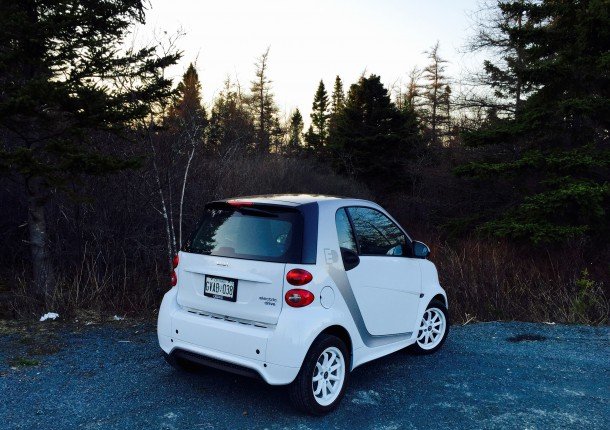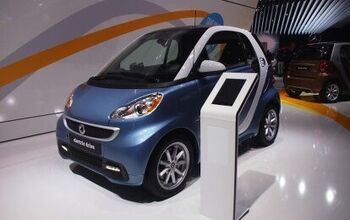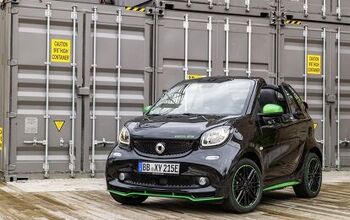2015 Smart Fortwo Electric Drive Review
I like Smarts.
It’s not a guilty pleasure, for I am not ashamed. It is a bizarre pleasure, however, lacking consistency and believability.
I’m a true blue car enthusiast with a love of V8 rumble, turbocharged torque, supercharged sizzle, manual shifters, and performance wagons. And yet, I can’t help myself: I like the way the Smart Fortwo steers. I’ve adapted to the way it wants to be shifted. I love the feeling of interior airiness. And I periodically enjoy well and truly pushing a car to its limits just to make proper forward progress. Approaching the limits in those performance cars I love? That’s a recipe for jail time.
As much as I like Smart Fortwos, my wife likes them a whole lot more. So in 2009, after our old Topaz, a new Civic, and a Santa Fe company car, she leased a second-generation model during a week of ridiculous Mercedes-Benz discounting that made the Fortwo significantly more affordable than any other new vehicle. The W451 wasn’t as efficient as the diesel model with which she fell in love in 2004, but it was thousands of dollars less expensive, much roomier inside, built better, and – in concert with the severe price cut – free to maintain. (The diesel 450 most certainly was not.)
She rarely drove the car outside the downtown core where we lived. Chief among the car’s annoyances wasn’t the transmission – the car really does force you into an unconventional acclimatization – but rather the difficulty of holding steady at the posted speed limit of 110 km/h. Fortwos prefer to settle in at an easy 130, a speed at which highway fuel consumption sharply increased. Cargo capacity and flexibility never ceased to amaze. The observed mileage far exceeded the Smart’s official ratings.
RATIONALIZING
No, not in our province, not in our lives, not even as a second car. A $30,000 two-seater with no performance credentials to speak of, no available tax rebates, lengthy charging times, and a dearth of ordinary creature comforts isn’t a recipe for success. This whole “compliance” electric car production works in a buyer’s favor with the right lease deal, in the proper U.S. jurisdiction, if they plan to operate a different primary car, and, of course, if they like Smarts.
DRIVING
More unusual is the stark difference between the way the Fortwo Electric Drive makes its way down the road in comparison with a normal second-generation Fortwo. The electric version is 16% heavier, and with the added weight settled low in the structure, the Electric Drive rides more sedately. But the steering is very heavy and rather unwilling to move far off centre.
Throttle calibration is nicely weighted, and the initial surge of torque is genuinely pleasing, as in so many electric cars. With no shifts to be completed, the Fortwo ED simply continues to build speed in a strange manner, so very unlike the normal Fortwo which, while in possession of passing power at highway speed, doesn’t exactly race down an on-ramp. The Electric Drive, on the other hand, is out of breath at higher speeds.
Brake feel is dreadful in this electric car, but the regen modes (through which you can cycle using the paddle shifters) can be so effective that one-pedal driving becomes commonplace. One-pedal driving is the best.
From a handling perspective, the weight which improves ride quality greatly reduces the feeling of agility that makes the regular Fortwo such a blast in the city. As a result, much of my reasoning for labelling the Fortwo as “fun” is lost, because this car isn’t nearly as enjoyable to hustle around town as the gas car.
RULING
A Fortwo Electric Drive and a normal Fortwo share another trait. They are most definitely acquired tastes, even for the previously indoctrinated. On day one, the Fortwo Electric Drive comes across as weird and mildly humorous. A day later, it’s simply weird. On day three, you’ve surely encountered an experience that causes it to be unfortunately weird and you’re not especially humored. Day four brings your mind around to weird but decently useful. On days five and six you’ve learned to drive the Fortwo as it wants to be driven, making it both weird and moderately fun.
By week’s end, it’s weird and likeable. But not sufficiently likeable, not with such limited range or at such a lofty price. Similarly equipped gas-fired Fortwos are at least $10,000 less, ride worse but handle better, accelerate slower but cruise more effectively, and are not limited by a charging cycle.
WAITING
The 2016 Fortwo will be slightly larger but still blissfully small. While the size causes such consternation in legions of buyers worried for their personal well-being, I always believed the Fortwo’s tidy dimensions produced odds which were ever in my favor. After all, there’s a lot less of me to hit.
Timothy Cain is the founder of GoodCarBadCar.net, which obsesses over the free and frequent publication of U.S. and Canadian auto sales figures. Follow on Twitter @goodcarbadcar and on Facebook.
More by Timothy Cain
Latest Car Reviews
Read moreLatest Product Reviews
Read moreRecent Comments
- W Conrad I'm not afraid of them, but they aren't needed for everyone or everywhere. Long haul and highway driving sure, but in the city, nope.
- Jalop1991 In a manner similar to PHEV being the correct answer, I declare RPVs to be the correct answer here.We're doing it with certain aircraft; why not with cars on the ground, using hardware and tools like Telsa's "FSD" or GM's "SuperCruise" as the base?Take the local Uber driver out of the car, and put him in a professional centralized environment from where he drives me around. The system and the individual car can have awareness as well as gates, but he's responsible for the driving.Put the tech into my car, and let me buy it as needed. I need someone else to drive me home; hit the button and voila, I've hired a driver for the moment. I don't want to drive 11 hours to my vacation spot; hire the remote pilot for that. When I get there, I have my car and he's still at his normal location, piloting cars for other people.The system would allow for driver rest period, like what's required for truckers, so I might end up with multiple people driving me to the coast. I don't care. And they don't have to be physically with me, therefore they can be way cheaper.Charge taxi-type per-mile rates. For long drives, offer per-trip rates. Offer subscriptions, including miles/hours. Whatever.(And for grins, dress the remote pilots all as Johnnie.)Start this out with big rigs. Take the trucker away from the long haul driving, and let him be there for emergencies and the short haul parts of the trip.And in a manner similar to PHEVs being discredited, I fully expect to be razzed for this brilliant idea (not unlike how Alan Kay wasn't recognized until many many years later for his Dynabook vision).
- B-BodyBuick84 Not afraid of AV's as I highly doubt they will ever be %100 viable for our roads. Stop-and-go downtown city or rush hour highway traffic? I can see that, but otherwise there's simply too many variables. Bad weather conditions, faded road lines or markings, reflective surfaces with glare, etc. There's also the issue of cultural norms. About a decade ago there was actually an online test called 'The Morality Machine' one could do online where you were in control of an AV and choose what action to take when a crash was inevitable. I think something like 2.5 million people across the world participated? For example, do you hit and most likely kill the elderly couple strolling across the crosswalk or crash the vehicle into a cement barrier and almost certainly cause the death of the vehicle occupants? What if it's a parent and child? In N. America 98% of people choose to hit the elderly couple and save themselves while in Asia, the exact opposite happened where 98% choose to hit the parent and child. Why? Cultural differences. Asia puts a lot of emphasis on respecting their elderly while N. America has a culture of 'save/ protect the children'. Are these AV's going to respect that culture? Is a VW Jetta or Buick Envision AV going to have different programming depending on whether it's sold in Canada or Taiwan? how's that going to effect legislation and legal battles when a crash inevitibly does happen? These are the true barriers to mass AV adoption, and in the 10 years since that test came out, there has been zero answers or progress on this matter. So no, I'm not afraid of AV's simply because with the exception of a few specific situations, most avenues are going to prove to be a dead-end for automakers.
- Mike Bradley Autonomous cars were developed in Silicon Valley. For new products there, the standard business plan is to put a barely-functioning product on the market right away and wait for the early-adopter customers to find the flaws. That's exactly what's happened. Detroit's plan is pretty much the opposite, but Detroit isn't developing this product. That's why dealers, for instance, haven't been trained in the cars.
- Dartman https://apnews.com/article/artificial-intelligence-fighter-jets-air-force-6a1100c96a73ca9b7f41cbd6a2753fdaAutonomous/Ai is here now. The question is implementation and acceptance.







































Comments
Join the conversation
I got a 2013 Smart ED in January 2014 as an experiment to see if I could live with an EV. At the time they were offering nothing down, $129/month for 36 months. With our state tax incentives in Georgia for ZEV, that makes it almost free. 20% off MSRP up to $5k tax credit. We had 3 other Mercedes and I rationalized it by saying that it is technically designed by Mercedes and matched our other three silver cars. In a short amount of time, I went from my regular commuter, a 2008 ML63 AMG to driving the Smart everyday. It makes sense in heavy traffic and tiny parking garages. On days of heavy traffic I use to get an indicated 7 mpg in my ML, where the Smart would get about 3.2 miles/kWh. My daily commute costs went from $7-8/day to $0.75. I liked commuting on backroads anyways so speeds never really got higher than about 55mph. The range proved not a problem in 6 months. It's great to be able to drive around and not have to worry about how much gas/$$$ you are wasting. Then one day in April 2014, I test drove the BMW i3 and a couple months later when they were released, ended up trading my ML63. The i3 is so much better than any other EV, even the Tesla for the price. I gave my father our E500 and we got another i3 for my partner's commute. Our second i3 is an even better deal than the Smart. I paid net about $1,500 for two years of driving or about $62/month after tax incentives and discount on left over 2014 i3. Not to mention we save over $300/month in gas for my ML and about $250/month for the E500.
I had a diesel fortwo for 9 years and loved it, but the maintenance was starting to get expensive, and at 180,000 km, was nearing the stage of everything having to be replaced a second time. When i got wind of the crazy lease deals last summer, i jumped on an ED, and i'm glad i did. I loved my diesel, but i'm over the moon in love with the electric drive. It suits 90% of the driving i do, and it's a BLAST to drive. The whine of the electric motor when you stomp on the "go" pedal is as addictive as the roar of a big internal combustion engine. And the torque! In Ontario, it was a sweetheart deal on the lease. Since Mercedes-Benz Financial is technically the "owner", they applied for the rebate on the lessee's behalf, and it essentially went toward the down payment, resulting in $100/month payments. Brilliant. What i made on the sale of my original diesel went toward getting a Level 2 charger installed.